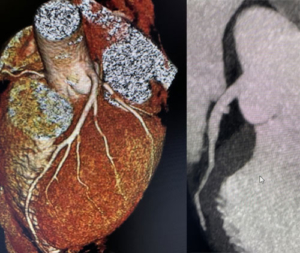CT Angiography of the Heart (CTA Coronary)
By TRA Radiologist
Jeanette Hemp, MD
“The best preparation for tomorrow is to do today’s work superbly well.” – Sir William Osler
The coronary arteries are the small arteries that supply blood to the heart muscle. When these small arteries become blocked, the heart muscle can become stressed and even die, otherwise known as myocardial infarction (MI) or a heart attack. Coronary artery disease is the build up of atherosclerotic plaque that can cause blockages in these small arteries. Common risk factors for coronary artery disease include smoking, poor diet and sedentary lifestyle. Coronary artery disease can cause chest pain, heart failure, irregular heart rhythms, and death from acute MI. Fortunately, for many people coronary artery disease can be detected and treated before it causes serious damage. For certain patients experiencing atypical chest pain coronary CT angiogram (CTA) is an important type of imaging test that does not involve undergoing a procedure or surgery.
The first coronary CTA was performed in 2004, and technology has rapidly improved since that time. Because the heart is always beating, there are several technical factors that must be addressed in order to obtain an excellent scan. Today’s CT scanners are able to detect small vessel size, correct for motion, discriminate between two adjacent structures and evaluate a curved vessel course. They are able to do this by infusing contrast through an IV and using many cameras that image at exact times dictated by the patient’s heart rate and cardiac cycle. When undergoing a cardiac CTA, the patient is typically given a medication to slow and even the heart rate and another medication to dilate the arteries. An echocardiogram (ECG) is obtained which is sent to the CT scanner in real time. Together, these techniques are able to generate very clear pictures of the coronary arteries in a few seconds. These pictures are evaluated specifically for coronary artery disease that can be repaired.
Not everyone is a candidate for coronary CTA and some patients will need to go directly for a procedure at the discretion of their cardiologist. But for many, this impressive technology can help detect coronary artery disease without the need for an invasive procedure.





